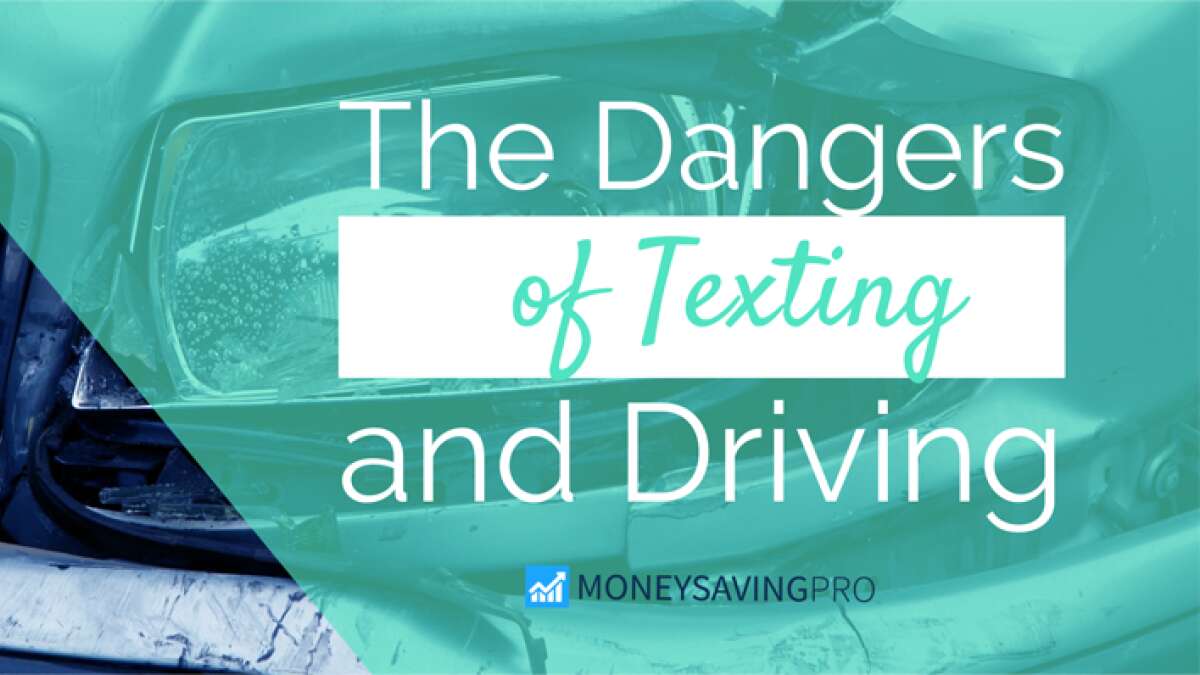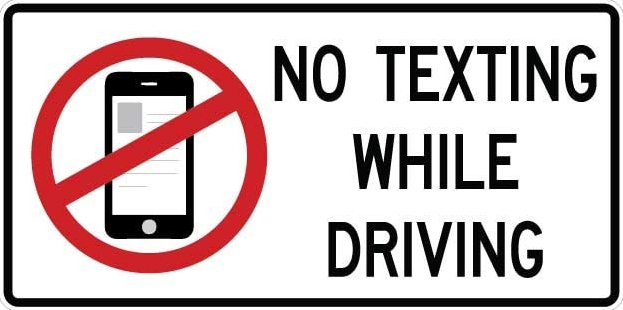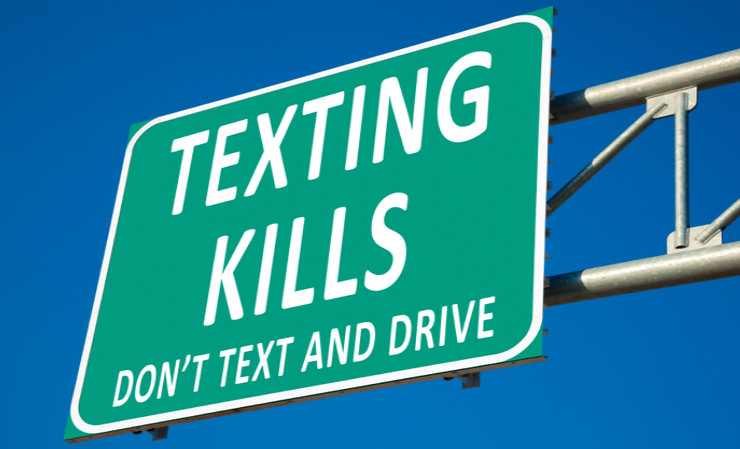
MoneySavingPro independently researches the products & services to bring you our recommendations. We may earn money when you click our links - disclosure policy.
I think we can all agree: new technology offers many benefits - computers have allowed lightning-fast data processing, the internet created a global world, and mobile phones provide us with convenience and a valuable safety tool.
Unfortunately, the law of unintended consequences almost always rears its ugly head when it comes to technological advances. In terms of cell phones, one of the most dangerous consequences has proved to be a rise in distracted driving.
More than three decades of successful campaigning have resulted in the number of drunk driving deaths being reduced by over half...the goal has now shifted to reducing the alarming number of accidents and deaths caused by a modern foe.
MADD - Mothers Against Drunk Driving
In the 1980s, MADD (Mothers Against Drunk Driving) brought national attention to the tragic number of annual deaths caused by drunk drivers. More than three decades of successful campaigning have resulted in the number of drunk driving deaths being reduced by over half - down from roughly 25,000 in 1980, to 9967 in 2014, according to the CDC (Centers for Disease Control and Prevention).
While this is encouraging news, the goal has now shifted to reducing the alarming number of accidents and deaths caused by the use of electronic devices while operating a motor vehicle.
Exactly how big is the problem of texting and driving? Below, I'll cover the hard numbers in terms of how many people commit this dangerous act and the serious safety issues it creates. I'll also talk about the legal status and ramifications of distracted driving across the U.S. and what you can do to fight this critical traffic safety hazard.
Finally, I'll answer your FAQ (frequently asked questions) about texting and driving.
Texting and Driving Facts
There is plenty of publicity surrounding this dangerous activity, such as the "It Can Wait" campaign from AT&T Wireless. Perhaps the most convincing argument, however, is the data that has been collected through studies and surveys on the dangers of texting while driving. Statistics on texting and driving can be eye-opening to those who don't see this as a real highway safety issue.

Part of a Larger Problem
While the government and other entities do track texting and driving statistics specifically to some extent, this behind-the-wheel behavior is also considered one element in a set of behaviors known as distracted driving.
Other distracted driving activities include eating, using a GPS, and fiddling with a radio. Experts, however, consider the dangers of texting and driving to be the most detrimental to motorist safety because it causes all three types of distractions defined by the CDC:
- Visual - taking your eyes off the road
- Manual - taking your hand(s) off the wheel
- Cognitive - taking your mind off driving
These three factors work in concert to create a potentially devastating situation for drivers, passengers, other motorists, bicyclists, and pedestrians. The problem is equally dangerous whether you're driving on a small country two-lane road or a multi-lane expressway - no matter where you are, distracted driving can easily turn into a tragedy.
Did You Know: If you injure someone as a result of distracted driving, you not only could hurt or kill someone or yourself, but you could also end up in court on charges of driver negligence.
Texting and Driving Statistics
- An estimated 341,000* auto accidents in 2013 involved texting and driving. (National Safety Council)
- 3179 people were killed in distraction-related car crashes in 2014. (U.S. Department of Transportation/Distraction.gov)
- Roughly 660,000 drivers are using an electronic device at any given time. (National Highway Traffic Safety Administration)
- Texting takes a driver's eyes off the road for an average of nearly five seconds - long enough to drive a football field's length (a football field is a whopping 360 feet long - over half the length of an average city block). (National Highway Traffic Safety Administration)
*The NSC points out that this number could be as high as 910,000. It's difficult to tell just how many auto accidents are attributable to reading or sending text messages. This is because determining the cause of a car accident is not an exact science. It relies upon the presence of eyewitnesses, along with a hefty dose of guesswork. The NSC believes that this causes the number to be heavily under-reported.
Distracted Driving Facts and Statistics
Sometimes the most revealing information is provided by the drivers themselves. Each year State Farm conducts a Distracted Driver Survey, which assesses driving behaviors and attitudes directly from the source. According to the 2015 survey, drivers admit to the following dangerous distracted driving activities:
- 51% talk on a handheld cell phone
- 29% access the internet (more than doubled since 2011)
- 21% read social media
- 19% take a picture with a cell phone
Americans have become accustomed to staying connected literally every minute of the day, and unfortunately this often includes while operating a vehicle.
The large jump in accessing the internet while driving is thought to be attributable in part to the increase in smartphone ownership over the past several years. The return of unlimited cell phone plans isn't likely to help the situation, as consumers are no longer as concerned about data usage.
Americans have become accustomed to staying connected literally every minute of the day, and unfortunately, this often includes while operating a vehicle.
Reaction Time
Car and Driver Magazine put texting and driving to a real-life test. They enlisted two interns to enact a series of scenarios, including texting with two hands while driving and becoming intoxicated with alcohol until reaching the legal limit of .08 percent. The results were shocking, yet not a huge surprise.
One of the interns had a reaction time - while texting - very similar to his baseline (reaction time measured under normal driving conditions). The other, however, had a reaction time triple his baseline while texting in the driver's seat. Add in two-handed typing, and the interns began drifting across lanes - a severe threat to public safety, particularly when driving on a two-lane road.
When it came time to climb behind the wheel while intoxicated, both interns had better reaction times as drunk drivers than while texting - sober - in the driver's seat.
Teens and Texting
One of the most alarming aspects of distracted driving is how prevalent it is among teenagers. This group is particularly vulnerable to the effects of texting and driving for a couple of reasons. Firstly, as brand new driver's license holders, they're inexperienced. Secondly, as a Common Sense Media poll showed, motor vehicle accidents are the leading killer of American teenagers.
Just how bad is this problem? Here are some statistics on teens and distracted driving:
- 43% of teens admit to texting while driving. (AT&T Teen Driver Survey)
- 58% of teen car crashes involve distracted driving (AAA Foundation).
- 40% of teenagers say they've been a passenger in a vehicle with a driver using a cell phone in a way that endangered them.
- Texting while driving is four times more common than drinking and driving among teens. (Forbes).
- 10% of drivers aged 15-19 who are involved in fatal car accidents are distracted at the time of the crash. (FCC)
- Teenagers are distracted nearly 25% of the time they're behind the wheel. (AAA Foundation)
This is clearly a major concern for parents, as well as an alarming traffic safety risk to everyone else sharing the road with novice drivers. Technology does offer solutions to help prevent this dangerous behavior, which I'll talk about in just a minute.
For more information on impaired driving, check out the CDC article.
Related: For tips and strategies on how to break cell phone addiction, head over here.
Texting and Driving Laws
There are no federal laws regarding sending or reading text messages while driving. It's up to each state to decide which driving activities are against the law. There are 46 states with a blanket texting ban on all drivers.

Many of these states have also enacted laws prohibiting new driver license holders, as well as bus drivers, from using a handheld cell phone or hands-free device.
States without a texting ban on all drivers:
- Arizona
- Missouri
- Montana
- Texas
Of the 46 states with a statewide ban, all but five states have primary enforcement. Primary enforcement allows an officer to issue a ticket regardless of whether another offense has been committed. Secondary enforcement means that a ticket can only be issued if the driver has already been pulled over for another offense.
States with secondary texting ban enforcement:
- Florida
- Iowa
- Nebraska
- Ohio
- South Dakota
You can find details of your state's specific bans on Distraction.gov.
Texting and Driving Prevention
It's true; all of these statistics are very scary. It's easy to feel helpless about the fact that you must share the road with people who may be putting you and your family in danger. There are solutions to texting and driving that you can participate in. One of the ways you can help is to join the efforts of groups that are spreading the word about the devastating effects of texting and driving and distractions on the road in general.
Distracted Driving Organizations
- Impact Teen Drivers: This organization, founded by the CEO of the California Association of Highway Patrolmen, offers online educational materials as well as school presentations.
- EndDD: End Distracted Driving was started by the parents of a 21-year-old woman who was killed by a distracted driver in 2009. They provide school and workplace presentations, as well as initiate community projects.
- S.A.D.D.: Students Against Destructive Decisions is run by young people working to educate other teens about the dangers of making bad life choices, including texting and driving.
There are multiple options if you want to get involved in this way. Contact your local law enforcement agency for ways to take action in your own community.
The government is stepping up to the plate on this serious public safety issue as well. The U.S. Department of Transportation routinely runs Blueprint for Ending Distracted Driving, which spurred pilot projects leading to bans on phone use while driving.
Set a Good Example
One of the most effective ways to prevent texting and driving is to practice safe driving habits yourself. This simple action may be more important than you think. According to the AT&T Teen Driver Survey, 77% of teens polled said that the same adults telling them not to text and drive actually "do it all the time." Kids tend to do as we do, not as we say. That's why it's crucial to show them that you take the issue very seriously by obeying the rules, the same way you do when it comes to wearing your seat belt.
One option is to set parental controls on your kid's device if you have a parental control app like the family locator.
Other Solutions to Texting and Driving
It's ironic that the same technology that causes the problem also provides a way to stop texting and driving. With texting and driving apps like Cellcontrol, you can restrict the functions available on a smartphone while the car is moving. This is a great way to get peace of mind while your teen is on the road.
Other things you can do to spread awareness:
- Share texting and driving facts and reliable informational websites with family and friends.
- Talk openly with your teen (and their friends) about the dangers of distracted driving.
- Make a rule that your kids are to call you for a ride rather than ride with someone who is known for using their device in a dangerous way.
- Put your own phone away or turn it off. If you must use it for directions, set the map to speak the directions, then place it out of your reach.
There's no excuse for texting and driving. If you openly regard it in the same way you do drinking and driving, you could impact the attitudes of others around you as well.
Did You Know: Texting at a red light is still considered texting and driving, just as if the vehicle was moving.
Recap
We certainly don't want to give up all of the wonderful things our smartphones bring to our lives. As with most things, however, there has to be some level of risk mitigation in order to enjoy the pros without adding undue cons.
If you never text and drive, you may not consider this issue to be something you need to pay much attention to. Remember, though, that others put you in danger when they engage in dangerous driving behaviors - highway safety is everyone's problem.
It's not just lives that are at stake, either. You may feel pain when it's time to compare car insurance quotes as well. According to insurance experts, rates have gone up an average of 16% since 2011. That rise is due in large part to the increase in claims resulting from distracted driving incidents. Additionally, you can look into car insurance to see if the provider's policies on texting and driving.
To learn more about the safety tips that both adults and teenagers should utilize when it comes to cell phone usage, you can read our ultimate guide to cell phone safety for kids.



